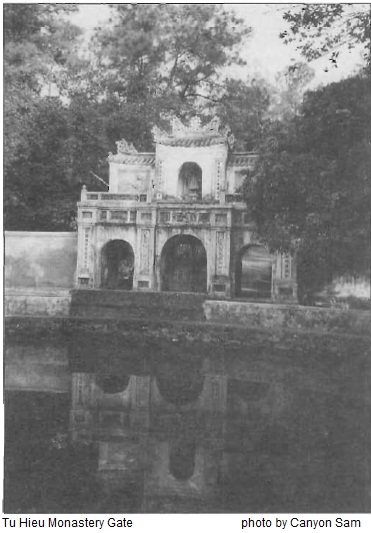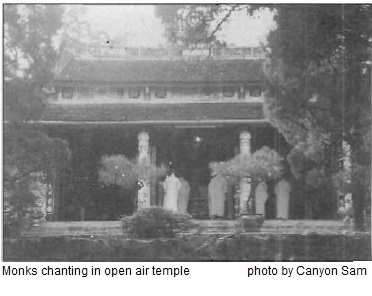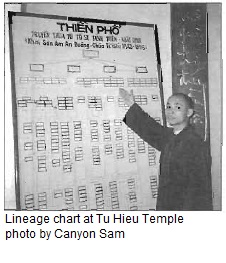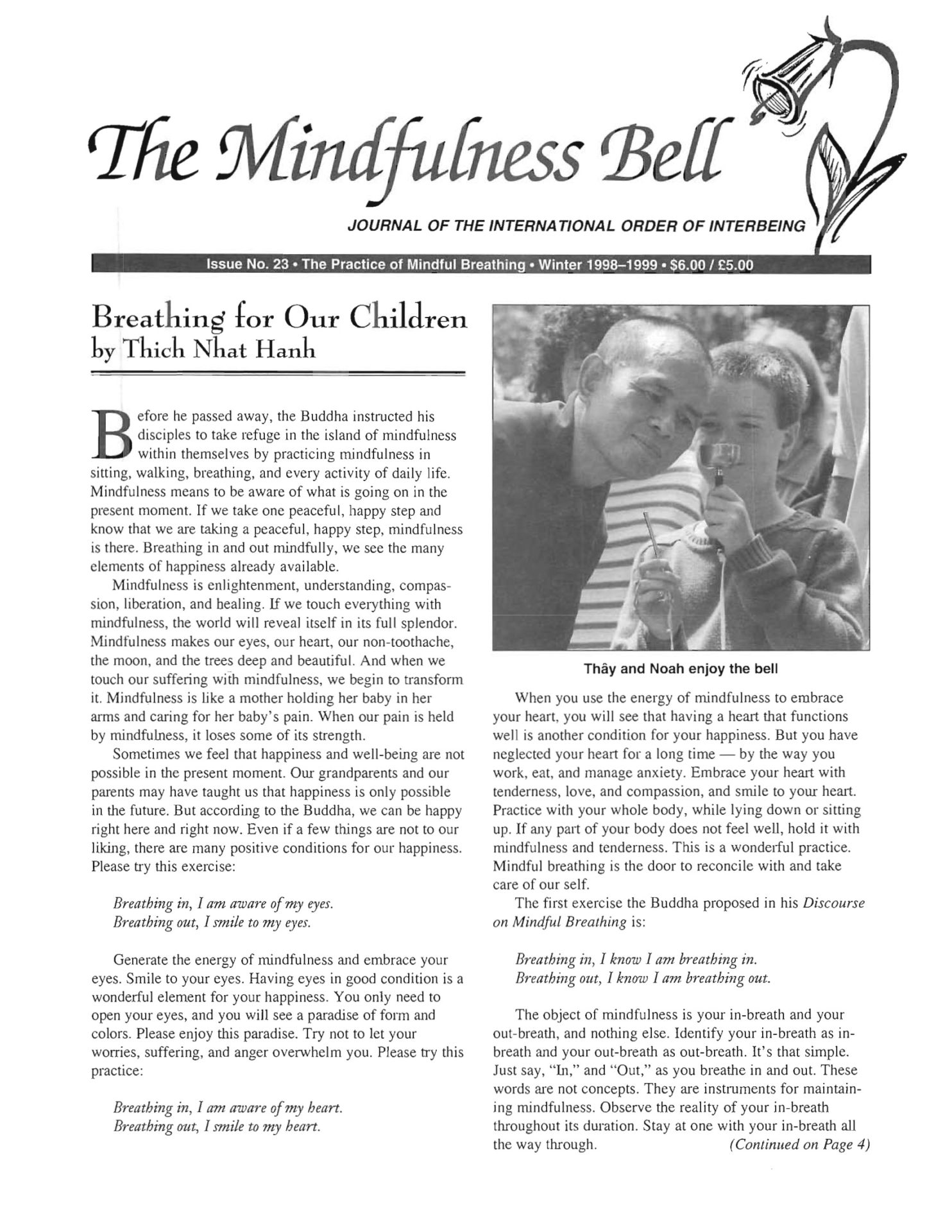By Canyon Sam
I called to the cyclo driver, swinging my arm back towards two white columns he’d just cycled past. My companion and I had started off early that morning with rented bikes to find Thay’s home monastery, Tu Hieu. All I knew was its name and its location southwest of Hue. After getting lost for a few hours, we’d taken all manner of conveyances to find our way here.
By Canyon Sam
I called to the cyclo driver, swinging my arm back towards two white columns he'd just cycled past. My companion and I had started off early that morning with rented bikes to find Thay's home monastery, Tu Hieu. All I knew was its name and its location southwest of Hue. After getting lost for a few hours, we'd taken all manner of conveyances to find our way here. Now it was late afternoon. The two white columns were the one distinguishing feature that indicated its presence down a red foot path leading into a pine forest.
I was struck by the triple-arched ornate gate and lovely crescent-moon lake at the entrance, not unlike the imperial entrances we'd seen the last two days at the Forbidden City and Mausoleums of former emperors. The sound of chanting resonated in the air. Soon we saw saffron and grey-robed monks standing in a gorgeous, 19th century, open-doored temple. We found our way to the abbot and a layman, who invited us to have tea with them on the rosewood outdoor patio. They were very pleased to hear we were students of Thay. In fact, they said, "You see?" and pointed at a poster-size photo of Thay on the wall. It was the photo from the cover of Being Peace.

It seems the abbot was ordained at the same time as Thay years ago, the same generation, but now Thay is higher, the highest, they told us. The layman said something about having been sent or gone with Thay to Princeton years ago. Every time they referred to him, they called him Most Venerable Thich Nhat Hanh.

We talked for awhile, overlooking a courtyard of meticulously tended potted bonsai trees. I quickly realized that not only was Thay trained as a young monk at this temple, and revered as an alumnus and Sangha brother, but that the entire spiritual training and philosophy here was his. Sitting, walking, nourishing the seeds of enlightenment in each other-even lazy days.
Thich Minh Nguyen, an English-speaking monk, gave us a tour to the meditation hall. The long, light-filled hall in the forest had a large color-coded chart in one corner, showing seven generations of the ordained members of this order, dating back to the 1843 founding. I saw Thay's name written on a green-lined nameplate among maybe three dozen others, preceded by the name Trung. On a red-lined nameplate below, among even more names, I found Sister Chan Khong's name. Each generation had one family name that preceded the member's own name. Thich Minh Nguyen asked my friend and me our Dharma names and when we told him, he told us we were the Tam generation, which meant heart. All the names in our generation were Bouquet of the Heart, or Lamp of the Heart, etc.
A poem handwritten in black-inked calligraphy on a lime green scroll hanging in the hall was written by Thay, Thich Minh Nguyen told us. We walked back through acres of fruit trees, past half finished brick buildings with stacks of red cinderblocks and wheelbarrows in front. New housing for monks, Thich Minh Nguyen said. How much like Plum Village it is, I thought, even down to the construction projects. The place had a sense of well-being, very grounded, and I sensed it was thriving. A schedule posted on the wall began at 3:30 in the morning and went till past 10:00 at night. Thich Minh Nguyen read it for us: sitting, walking, working, eating, Dharma study, prayers. The only surprising thing was the monks' session of Kung Fu every evening! Suddenly I understood the model after which Plum Village had been established. And I understood the full meaning of bowing to our spiritual ancestors in the Five Prostrations.

We saw the altar to the monastery founder, his hand-drawn portrait framed in black lacquer, and walked among the graves of all the temple's abbots in a cool, pine-shaded grove. I had been in Vietnam for two weeks, touring the main sites. It had taken days to get here from San Francisco, and though I loved being in Asia and seeing Vietnam, because of the language and the tourist groove we were in, I hadn't made a strong connection. Out of this, and out of hours and hours of cycling around lost through the countryside we had arrived here and found these deep spiritual roots, this never-before-seen part of our spiritual lineage, and found a whole community practicing as we were taught to practice on the other side of the world.
Thay sometimes takes a pencil or a chopstick during a lecture and holds it horizontally to illustrate his point, and then turns it vertically and talks some more. I saw these lines again in my mind. I saw the vertical line. Below midpoint were all our ancestors who had come before us; above midpoint were all in the future who would follow us. Our responsibility to the generations who follow us is to do the same that has been done for us, or better, and our responsibility to the generations before us is to honor them for all they had done. We were no more and no less than part of this continuum of awakening. When I see the horizontal line, I see ground zero, that all of us on the earth now doing the practice are linked together. And then we are linked to the vertical line, at the midpoint. Therefore the place of the most energy and possibility is this center axis the here and now. The inhale and the exhale. The precious moment and the only moment. Here and now we inter-are across time and space from practitioners in pine forest temples in Asia, to traintrack-lined warehouses in Oakland, to hays tacked hills in France, and across the generations. I saw this, like this, as if for the first time.
Canyon Sam, Bouquet of the Heart, is a San Francisco writer and performance artist. Her nationally acclaimed solo show, "Taxi Karma and the Dissident, " about her travels in Tibet and work with Buddhist nuns, plays in March at the Working Women's Theater Festival. She is author of the forthcoming book, One Hundred Voices of Tara: Untold Stories of Tibetan Women.

